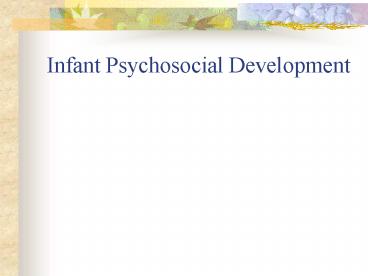Infant Psychosocial Development - PowerPoint PPT Presentation
1 / 22
Title:
Infant Psychosocial Development
Description:
At 6-9 months, emotions become more differentiated. Emotional Development. Emotions ... 2. Rhythmicity: regularity of body functions ... – PowerPoint PPT presentation
Number of Views:117
Avg rating:3.0/5.0
Title: Infant Psychosocial Development
1
Infant Psychosocial Development
2
Emotional Development
- Early Emotions distress (through crying) and
pleasure - first smiles at border between states
- social smiles _____ weeks
- laughter 3 to 4 months
- At 6-9 months, emotions become more differentiated
3
Emotional Development
- Emotions
- _________ _______ starts 6 months, prominent
at 10-14 months - ______ ____________ used
- __________ _____ starts 8-9 months, peaks at 14
months, then declines - these actually reflect a cognitive advance!
4
Emotional Development
- Complex emotions (shame, guilt, envy,
embarrassment, etc.) - arise as _____ ___ _____ develops
- see rouge test
- recognizes self in mirror at __ months of age
5
Test Your Knowledge
- When a 7 month old baby encounters an unfamiliar
person, s/he is likely to show - A. stranger anxiety
- B. separation anxiety
- C. joy
- D. social referencing, if the parent is near
- E. more than one of the above
6
Test Your Knowledge
- When a 1 year old baby girl sees her reflection
in the mirror, - A. she is likely to recognize that it is the self
in the mirror - B. she is not likely to recognize that it is the
self in the mirror
7
Temperament
- 9 dimensions of temperament (Thomas Chess)
- 1. ______ _____ amount of movement
- 2. Rhythmicity regularity of body functions
- 3. Approach-withdrawal first reaction to new
situation
8
Temperament
- 9 dimensions of temperament (Thomas and Chess)
- 4. Adaptability extent of adjustment over time
- 5. Intensity strength of reaction to inside or
outside events - 6. _________ strength of stimulus needed to
respond
9
Temperament
- 9 dimensions of temperament (Thomas and Chess)
- 7. Mood pleasant, unpleasant
- 8. _______________ extent to which ongoing
activities can be interrupted - 9. Persistence of attention how long child stays
with an activity or returns to it after
interruption
10
Test Your Knowledge
- Jamie screams at the top of her lungs when her
throat hurts, while Tyler just whimpers when he
has a sore throat. They differ in which dimension
of temperament? - A. threshold
- B. intensity
- C. adaptability
11
Test Your Knowledge
- When Susie crawls toward an electrical outlet,
her Mom calls out to Susie to look at the pretty
bird that has just landed on the bird feeder.
Susie immediately goes to look at the bird. Which
dimension of temperament does this describe? - A. distractability
- B. persistence of attention
12
Temperament
- 3 general types of temperament
- ____
- _________
- slow to warm up
- Need ________ __ ___ between temperament and
parenting
13
Sensitive Care A Dance
- Sensitive care/parenting
- awareness of infants signals
- timely, correct, empathic response
14
Sensitive Care A Dance
- Sensitive care/parenting
- interactional synchrony between P C
- resembles a _____
- baby signals when ready to interact and when
needs a break - parent follows signals
- contributes to trust/security
15
Infant Psychosocial Tasks
- Erikson
- _____ __ _______ crisis of infancy
- autonomy vs. shame and doubt crisis of
toddlerhood
16
Attachment
- Attachment close, lasting emotional bond
- develops across time (repeated interactions)
- normal infant development requires this bond
- but __ ______ _____in minutes right after birth
17
Attachment
- Attachment
- is seen through proximity-seeking and _______
___________ behaviors
18
Attachment
- Ainsworth Strange Situation Procedure
- for assessing attachment in lab setting
- does child _______ ____?
- does child react when parent leaves?
- does child seek _______ when parent returns?
19
Attachment
- Patterns of Attachment
- ______ associated with later competence
- anxious-resistant (ambivalent)
- anxious-avoidant
- disorganized/disoriented
20
Attachment Effects Elsewhere
- Attachment affects other domains
- If securely attached (willing to play and explore
toys), will learn (_________ domain) - If attachment figure disappears, might show
physical symptoms (________ domain)
21
Test Your Knowledge
- In the Strange Situation procedure, 18 month old
Kia ignores her mother when the mother returns to
the room after Kia was all alone. Which pattern
of attachment would you suspect? - Anxious-avoidant
- Anxious-resistant
- Disorganized/disoriented
22
Test Your Knowledge
- In the Strange Situation procedure, 18 month old
Kia wont leave her moms side at the beginning
of the procedure. She sobs when mom leaves the
room and wants to be picked up when mom returns.
She kicks mom when mom picks her up. Which
pattern of attachment is she displaying?































